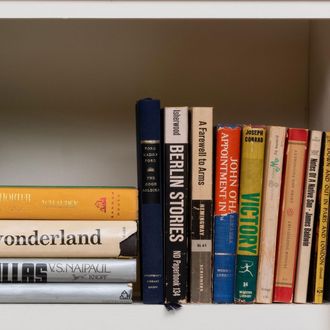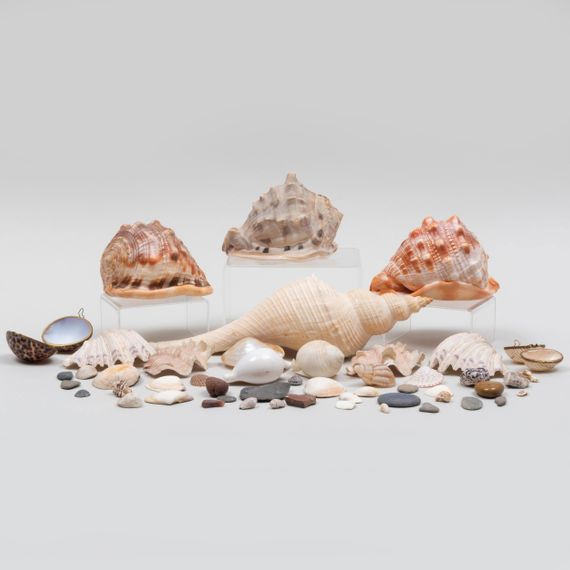
They let me put on her sunglasses. You know the ones — big, dark, Céline, tortoise shell. How did they make me feel? Great, honestly. Very cool. My first thought: run. Take ’em. I pictured myself fleeing the gallery, bursting out onto the street. The staff would have been surprised, so I’d have had a head start. Then the adrenaline would have kicked in. I’m confident I could have gotten away with the $27,000 sunglasses.
On Wednesday, Stair Galleries in Hudson, New York, auctioned off some of Joan Didion’s possessions, with the proceeds going to Parkinson’s research at Columbia University and the Sacramento Historical Society. Maybe you read about it. In the lead-up to the sale, as bidding opened online on October 31, every outlet sent a correspondent and every correspondent pored over the details. Didion died last year at 87, and the sale perhaps marks a winding down of a public mourning period, which has included a memorial at the Cathedral Church of St. John the Divine in Manhattan in September, and an ongoing exhibit at the Hammer Museum in L.A. through February 2023.
The auction included fine art, furniture, books, and bric-a-brac from Didion’s Upper East Side apartment. I visited the week of November 7 and the items took up two rooms of the gallery. In person, the scale was modest. Certain spaces of Didion’s home had been recreated, the tableau on her desk, the layout of the slipcovered sofas from her living room. Books were bundled by author or theme: books about New York, books on Richard Avedon, books by women poets.
Lisa Thomas, director of the fine-arts department at Stair, said, “We took these books right off of her bookshelves and they’re, for the most part, really well-worn and used. She read and reread her books from her library.” She told me about the amount of interest the sale had gotten (lots), and about the buzziest items (the sunglasses, a group of 13 blank notebooks that went “sort of viral”).
There was a brass Cartier desk clock. It’s elegant, a nice size, though non-operational and has some “some minor pitting to the metal” I liked. A small stack of Elizabeth Hardwick books would have slipped easily into my tote. I’d have taken the Richard Serra painting, a black quadrilateral on a cream background, pleasantly severe. It would have looked great in my house, and what a story.
She had nice things, Thomas and I agreed. Thomas called her style “part of this sort of ’70s, California, boho, creative thing that was going on. And then you mix it with this New York literary chic.”
I thought, before I showed up to the gallery, Why bid on someone’s dusty old stuff? It felt akin to owning movie props. The Bat Suit, or something. Dorothy’s ruby slippers. It seemed like a Planet Hollywood impulse, part of our national obsession with celebrity. What are you going to do with Joan Didion’s hurricane lamp, I thought, make an altar?
But then I tried on the sunglasses. They had been designated “Lot 5” and by the time I put them on, the leading bid was $3,200. Their final price tag could clear $5,000, I speculated (naïvely). For $440, you could buy them brand new. You could buy them anytime on the Céline website. But I can’t deny that I felt a charge when I put them on. I know it was imagined. I know that nothing of a writer’s essence clings to her possessions after death. I know genius is not transferable via luxury goods. And yet.
***
The auction was held virtually, like all of Stair Galleries’ auctions since the pandemic hit. Thomas told me they miss seeing clients in person, but the energy of a live auction is not lost online. Watching the bidding, I could see what she meant. Founder and president Colin Stair ran it over an exciting, nerve-wracking several hours. He took bids from three different online platforms. A handful of people in the room with him shouted out call-in bids. It went exactly like an auction from every movie you’ve ever seen.
Things began going off the rails when the first painting went for $110,000. Up until then, the bidding had been competitive, but somewhat reasonable. Lot 1, a group of Didion’s copies of her own books, sold for $15,000. That made sense, I thought. Hardcore book collectors would want those. Lot 2, a photo of Didion in a black turtleneck, went for $17,000. Well, okay, a beautiful, iconic photo. Lot 3 was where the big spending began. It was a collection of 15 books Didion liked to read every year, including Joyce Carol Oates’s Wonderland, Renata Adler’s Speedboat, and V.S. Naipaul’s Guerillas. The bidding had been only $300 online but went up to $26,000 in a matter of moments.
Lot 4 was the painting, a portrait of Didion by Leslie Johnson painted in 1977, and given to Didion as a gift. It’s rendered in peach, gray, and tan. Didion’s sitting up in bed and looking at the viewer with one sad eye. The bidding began, and it kept going. At a certain point, it stopped increasing in $1,000 increments and switched to $5,000 increments.
Then we got to Lot 5, the sunglasses (my sunglasses). Bidding opened at $10,000. Final price $27,000. I had an irrational feeling, around the $20,000 mark — that I’d like to see them go for a million dollars. If we’re going to lose all sense of proportion, I thought, let’s go big.
The rest of the auction went much the same way for 224 lots. Two photographs of Didion with her famous Stingray sold for $24,000 and $26,000. Her desk, made famous in a photograph of her with her daughter, Quintana, and her husband, John, amid walls of books, went for $60,000. The blank notebooks I spoke to Thomas about went for $9,000. A kind of ugly rattan chair went for $28,000. Maybe the funniest was Lot 50, a bunch of seashells and pebbles — literal rocks, from the ground. For rocks from the ground and shells from the sea, an anonymous bidder paid $7,000.
***
When I think of objects in Didion’s writing, I recall: Jim Morrison’s black vinyl pants worn without underwear, the record Blonde on Blonde, Quintana’s 66 christening dresses. And, of course, the famed packing list from the title essay of The White Album. The popularity of the list annoys me. Women’s publications love to suggest readers also pack this way (“2 skirts, 2 jerseys or leotards, 1 pullover sweater,” and so on). It’s easy to forget that the essay the list is from is about, among other things, the Manson murders and Didion’s own deteriorating mental health. She packed like that to try to impose order on a world gone mad.
Taking the list out of context and emulating it is silly, but I don’t think Didion’s personal style can be dismissed so easily. The auction would indicate I’m not alone. The swirl of signifiers in her writing conjures Manhattan, Malibu, the glamorous heyday of the publishing industry, a mythical and monied American West. In “The White Album,” and elsewhere in her work, the objects are not beside the point; they are the point precisely.
Still, $27,000 for sunglasses. $7,000 for pebbles.
Can we take the results of this auction to mean people care a lot about literature? Can we feel comforted that so much money will go to charity? Or is this a bizarre display of avarice? Vultures with carrion? I have a few friends who were moved by Didion’s writing and placed modest bids before the prices hit the stratosphere. Was what they wanted weird or gross?
Most of us can’t afford to own something of Didion’s, but if you’re a fan, you own a piece of her already. You own the most intimate and personal piece of her it is possible for a stranger to own. It’s your unique interpretation of her work. The way it lived in your mind as you read it. I don’t know how a pair of sunglasses can compare to that.


